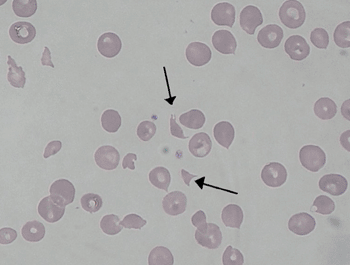Fragmented Red Blood Cell Measurement Automated
By LabMedica International staff writers
Posted on 02 Jul 2012
The laboratory diagnosis of thrombotic microangiopathies (TMA) or disorders that may mimic their features remains difficult. Posted on 02 Jul 2012
The detection of schistocytes on the blood smear is a cornerstone finding to assess the diagnosis, but microscopic evaluation of schistocytes is still problematic with wide inter-observer variations.

Image: Schistocytes in blood smear (Photo courtesy of Dr. Paulo H.O. Mourao).
Hematologists at the University Hospital (Nancy, France) conducted studies comparing automated and microscopic counts of Fragmented Red Blood Cells (FRC) and schistocytes. The data came from the day-to-day analysis of more than 90,000 peripheral blood (PB) samples for 10 years in four centers. More than 900 patients were examined because of a clinical suspicion of TMA and 17 samples were derived from preterm newborns who were supposed to give the highest FRC counts among nonpathologic samples.
FRC were counted by automated direct measurement using the two automated analyzers (ABCC): the ADVIA 120 analyzer (Siemens; Tarrytown, NY, USA) and the XE-2100 analyzer (Sysmex; Kobe, Japan). Schistocyte counting was carried out from May-Grünwald-Giemsa-stained PB smears. The reference range for FRC was less than 0.3% for the ADVIA and less than 0.5% for the Sysmex XE-2100.
The correlation coefficient for Siemens devices was around 0.7. The main problem resulted from an overestimation of FRC as compared to schistocytes from 0.4% to 0.5% for a count of schistocyte ranging from 0% to 1.5%. Conversely, the scientists observed an underestimation of FRC as compared to schistocytes subsequent to this 1.5% threshold. For the Sysmex XE-2100 counter, the overestimation of the FRC was more pronounced, at less 0.8%, and increased slightly with high schistocyte percentages. The presence of FRC below a threshold determined at 1% for both automated analyzers had a negative predictive value (PV) close to 100% to exclude the presence of schistocyte on the blood smear, but in relationship with a poor positive PV value.
The authors concluded that that systematic quantification of FRC might improve the laboratorians' ability to exclude samples with schistocytes. This should be especially useful among patients in whom TMA diagnosis is suspected. However, several limitations deserve consideration such as few false-negative FRC counts in a context of macrocytosis, great lack of specificity. Hence, a PB smear examination was still advised for the validation of the count if needed. The study was published on June 14, 2012, in the International Journal of Laboratory Hematology.
Related Links:
University Hospital
Siemens
Sysmex













